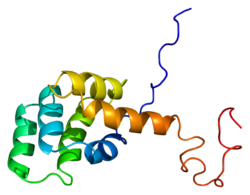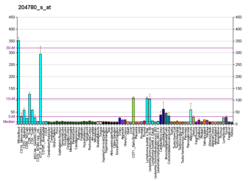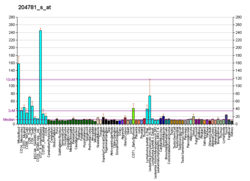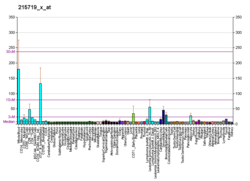
Back Fas receptor Czech FAS Welsh Fas-Rezeptor German Receptor FAS Spanish گیرنده فاس Persian Récepteur Fas French Receptor Fas Galician CD95 ID Recettore Fas Italian Fas受容体 Japanese
The Fas receptor, also known as Fas, FasR, apoptosis antigen 1 (APO-1 or APT), cluster of differentiation 95 (CD95) or tumor necrosis factor receptor superfamily member 6 (TNFRSF6), is a protein that in humans is encoded by the FAS gene.[5][6] Fas was first identified using a monoclonal antibody generated by immunizing mice with the FS-7 cell line. Thus, the name Fas is derived from FS-7-associated surface antigen.[7]
The Fas receptor is a death receptor on the surface of cells that leads to programmed cell death (apoptosis) if it binds its ligand, Fas ligand (FasL). It is one of two apoptosis pathways, the other being the mitochondrial pathway.[8]
- ^ a b c GRCh38: Ensembl release 89: ENSG00000026103 – Ensembl, May 2017
- ^ a b c GRCm38: Ensembl release 89: ENSMUSG00000024778 – Ensembl, May 2017
- ^ "Human PubMed Reference:". National Center for Biotechnology Information, U.S. National Library of Medicine.
- ^ "Mouse PubMed Reference:". National Center for Biotechnology Information, U.S. National Library of Medicine.
- ^ Lichter P, Walczak H, Weitz S, Behrmann I, Krammer PH (September 1992). "The human APO-1 (APT) antigen maps to 10q23, a region that is syntenic with mouse chromosome 19". Genomics. 14 (1): 179–80. doi:10.1016/S0888-7543(05)80302-7. PMID 1385299.
- ^ Inazawa J, Itoh N, Abe T, Nagata S (November 1992). "Assignment of the human Fas antigen gene (Fas) to 10q24.1". Genomics. 14 (3): 821–2. doi:10.1016/S0888-7543(05)80200-9. PMID 1385309.
- ^ Nagata S (July 2004). "Early work on the function of CD95, an interview with Shige Nagata". Cell Death and Differentiation. 11 (Suppl 1): S23-7. doi:10.1038/sj.cdd.4401453. PMID 15143352.
- ^ Wajant H (May 2002). "The Fas signaling pathway: more than a paradigm". Science. 296 (5573): 1635–6. Bibcode:2002Sci...296.1635W. doi:10.1126/science.1071553. PMID 12040174. S2CID 29449108.
© MMXXIII Rich X Search. We shall prevail. All rights reserved. Rich X Search







